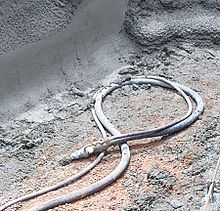This article needs additional citations for verification. (February 2010) |







Shotcrete, gunite (/ˈɡʌnaɪt/), or sprayed concrete is concrete or mortar conveyed through a hose and pneumatically projected at high velocity onto a surface. This construction technique was invented by Carl Akeley and first used in 1907.[1]: 7 The concrete is typically reinforced by conventional steel rods, steel mesh, or fibers.
The concrete or mortar is formulated to be sticky and resist flowing when at rest to allow use on walls and ceilings, but exhibit sufficient shear thinning to be easily plumbable through hoses.
Shotcrete is usually an all-inclusive term for both the wet-mix and dry-mix versions invented by Akeley. In pool construction, however, shotcrete refers to wet mix and gunite to dry mix. In this context, these terms are not interchangeable.
Shotcrete is placed and compacted/consolidated at the same time, due to the force with which it is ejected from the nozzle. It can be sprayed onto any type or shape of surface, including vertical or overhead areas.
Shotcrete has the characteristics of high compressive strength, good durability, water tightness and frost resistance.[2]
- ^ Cite error: The named reference
hoflerwas invoked but never defined (see the help page). - ^ Hu, Zhao; Ding, Hao; Lai, Jinxing; Wang, Hao; Wang, Xiuling; He, Siyue (2018). "The durability of shotcrete in cold region tunnel: A review". Construction and Building Materials. 185: 670–683. doi:10.1016/j.conbuildmat.2018.07.088. S2CID 139503874. Retrieved July 12, 2022.